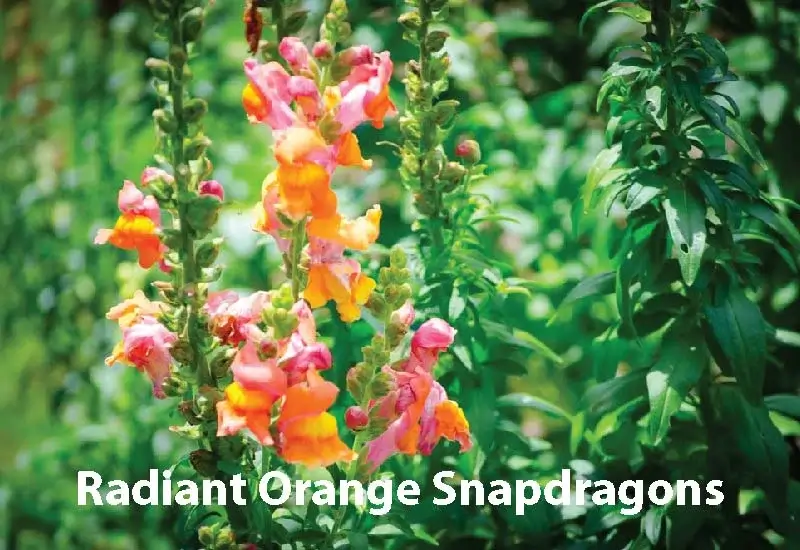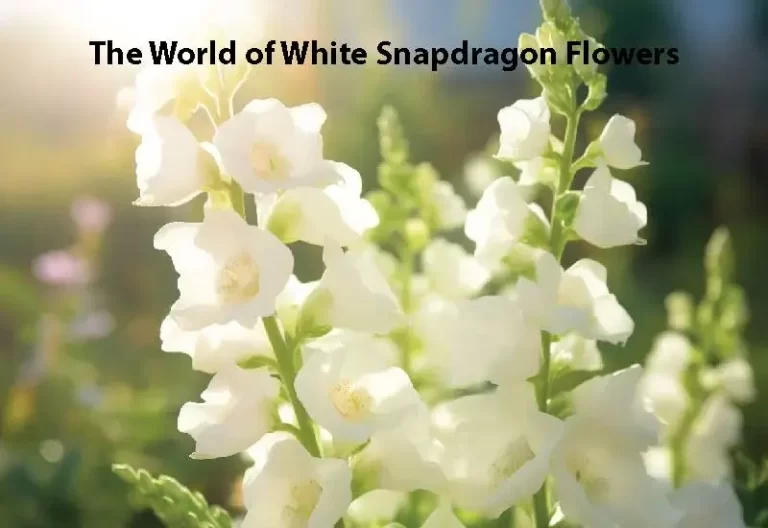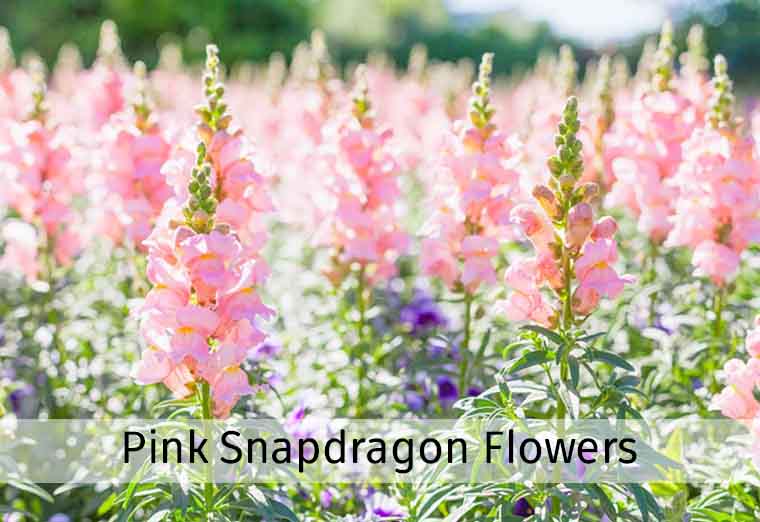Radiant Orange Snapdragons: Nature’s Vibrant Delight

Introduction
Orange snapdragons belong to the Antirrhinum genus and are a member of the Scrophulariaceae family. Their name, “snapdragon,” is derived from the flower’s resemblance to a dragon’s mouth when the petals are gently squeezed. This distinctive feature adds an element of whimsy and intrigue to your garden.
The Rich Palette of Orange Snapdragons
When it comes to orange snapdragons, the world of color is anything but monotonous. The rich palette of orange snapdragon flowers offers a spectrum of shades, ranging from warm and fiery to soft and muted. These variations in color allow you to choose the perfect shade to complement your garden’s overall aesthetic.
In the world of orange snapdragons, you’ll encounter shades like tangerine, apricot, coral, and burnt orange. Each hue brings its unique character and charm to your garden or floral arrangements. Whether you’re aiming for a bold and vibrant statement or a more subtle and harmonious blend, the rich palette of orange snapdragons provides endless possibilities for creative expression.
Orange Snapdragon Seed
Growing orange snapdragons from seeds is an enjoyable and rewarding gardening project. Here’s a step-by-step guide to help you get started:
Materials You’ll Need:
- Orange snapdragon seeds
- Seed trays or pots
- Seed-starting mix
- Watering can or spray bottle
- Plastic wrap or a clear plastic dome
- Grow lights or a sunny windowsill
- Small garden tools for transplanting
Steps to Grow Orange Snapdragon Seeds:
Select Quality Seeds:
- Choose high-quality orange snapdragon seeds from a reputable supplier. Ensure the seeds are fresh and suitable for the variety you want to grow.
Prepare Seed Trays or Pots:
- Fill seed trays or individual pots with a seed-starting mix. This mix provides good drainage and aeration for young seedlings.
Sow the Seeds:
- Gently press the orange snapdragon seeds onto the surface of the seed-starting mix. Avoid burying them, as they need light to germinate.
Mist or Water:
- Lightly mist the surface of the soil or use a gentle watering can to ensure the seeds have good contact with the soil. Be careful not to overwater, as this can lead to mold or rot.
Create Humidity:
- Cover the seed trays or pots with plastic wrap or a clear plastic dome to create a humid environment for germination.
Provide Light:
- Place the trays or pots in a location with indirect sunlight or use grow lights. Orange snapdragon seeds require light to germinate. Maintain a temperature of around 70°F (21°C).
Monitor Germination:
- Check regularly for germination, which can take anywhere from 10 to 21 days. Once seedlings have emerged, remove the plastic cover.
Transplant Seedlings:
- When the orange snapdragon seedlings are large enough to handle and have a couple of sets of true leaves, transplant them into larger pots or directly into your garden. Space them according to the variety’s requirements.
Outdoor Planting:
- Select a sunny to partially shaded location in your garden with well-draining soil.
- Space the transplants about 6-12 inches apart, depending on the variety.
Care for Seedlings:
- Keep the soil consistently moist during the growing season.
- Apply a balanced, all-purpose fertilizer according to the package instructions.
- Remove spent flowers (deadhead) to encourage continuous blooming.
With patience and care, you can grow beautiful orange snapdragons from seeds and enjoy their vibrant and cheerful blooms in your garden. Be sure to follow specific care instructions for the orange snapdragon variety you choose, as they may have slight variations in their growth requirements.
Caring for Orange Snapdragons: Gardening Tips and Tricks
Growing and caring for orange snapdragons can be a rewarding experience, but they do require some specific attention to thrive. Here are some gardening tips and tricks to ensure your orange snapdragons flourish:
1. Location: Orange snapdragons thrive in well-draining soil and prefer full sun or partial shade. Choose a location that receives at least six hours of sunlight daily.
2. Soil: Ensure the soil is well-draining and enriched with organic matter. Good soil quality is essential for healthy root development.
3. Watering: Keep the soil consistently moist but not waterlogged. Water at the base of the plant to avoid wetting the foliage, which can lead to diseases.
4. Fertilization: Apply a balanced, all-purpose fertilizer during the growing season. Follow the package instructions for the correct dosage.
5. Deadheading: Regularly remove spent flowers to encourage continuous blooming and prevent the plant from going to seed prematurely.
6. Pest and Disease Control: Monitor for common garden pests like aphids and treat them promptly. Proper air circulation can help prevent mold and mildew.
The History and Symbolism of Orange Snapdragons
Orange snapdragon flowers have a rich history that spans cultures and centuries. In many cultures, they are revered for their unique appearance and vibrant color. Let’s delve into the history and symbolism of these captivating blooms.
Historical Significance: Snapdragons, including orange varieties, have been cultivated for centuries. They were believed to have mystical powers in some ancient cultures, protecting against evil spirits and curses.
Symbolism: Orange snapdragons are often associated with enthusiasm, warmth, and a zest for life. Their vibrant hue symbolizes energy and radiance, making them a popular choice for celebrations and events.
Designing with Orange Snapdragons: Garden Ideas and Inspiration
Designing a garden that features orange snapdragons can be an exciting and creative endeavor. These fiery blooms can add a burst of color and a touch of whimsy to your outdoor space. Here are some garden ideas and inspiration to get you started:
Warm Color Palettes: Incorporate orange snapdragons into gardens with warm color palettes, such as reds, yellows, and pinks, to create a vibrant and inviting atmosphere.
Complementary Flowers: Pair orange snapdragons with complementary flowers like marigolds, zinnias, or sunflowers for a visually stunning garden display.
Container Gardens: Use orange snapdragons in containers and pots on your patio or balcony to bring a pop of color to small spaces.
Wildflower Gardens: Add a touch of wild beauty by incorporating orange snapdragons into a meadow-style garden alongside native grasses and other wildflowers.
Orange Snapdragons in Floral Arrangements: Adding Zest to Bouquets
Orange snapdragons are a versatile addition to floral arrangements. They can inject energy and vitality into bouquets, whether used as the focal point or as an accent. Here are some tips for adding zest to your floral arrangements with orange snapdragons:
Bold Centerpieces: Create striking centerpieces by using orange snapdragons as the main attraction. Pair them with contrasting colors like purple or blue for a dynamic effect.
Mixed Bouquets: Incorporate orange snapdragons into mixed bouquets with complementary flowers to add depth and vibrancy to your arrangements.
Casual Elegance: Use orange snapdragons in more casual floral designs, like garden-style bouquets, for a rustic and charming look.
Attracting Pollinators with Orange Snapdragons
Orange snapdragon flowers are not only a visual delight but also a valuable resource for pollinators in your garden. Bees, butterflies, and hummingbirds are attracted to their nectar-rich blooms. Here’s how you can attract and support pollinators with orange snapdragons:
Strategic Planting: Place orange snapdragons near other pollinator-friendly plants to create a pollinator-friendly oasis in your garden.
Continuous Blooms: By deadheading spent flowers regularly, you encourage orange snapdragons to produce more blooms, providing a consistent food source for pollinators.
Native Varieties: Consider planting native varieties of orange snapdragons to attract local pollinators that are adapted to your region.
The Language of Orange Flowers: What Do Snapdragons Convey?
In the world of flowers, colors often carry specific meanings and sentiments. Orange snapdragons, with their vibrant hue, are no exception. Understanding the language of orange flowers can help you convey your feelings and intentions through your floral choices.
Expressing Enthusiasm: Orange snapdragons are a symbol of enthusiasm and energy. When you gift someone a bouquet of orange snapdragons, you’re conveying a message of excitement and passion. It’s a way to express your enthusiasm for a new endeavor, a celebration, or a joyful occasion.
Warmth and Friendship: Orange, being a warm and inviting color, also signifies friendship and a welcoming spirit. You can use orange snapdragons to extend a warm welcome to guests or as a thoughtful gesture to a friend.
Celebration and Success: The vibrancy of orange snapdragons makes them an excellent choice for celebrating achievements and milestones. They can be a meaningful addition to congratulatory bouquets, expressing pride and support.
Renewal and Growth: Orange is reminiscent of the sun and the changing seasons. In this context, orange snapdragons can symbolize renewal and personal growth, making them a fitting gift during times of transformation or self-discovery.
Understanding the language of orange snapdragons allows you to use these vibrant blooms to communicate your emotions and intentions effectively.
Seasonal Splendor: When and Where to Enjoy Orange Snapdragons
The beauty of orange snapdragons extends beyond their vibrant color; it also lies in their seasonal splendor. Knowing when and where to enjoy these blooms can enhance your gardening and floral experiences.
Blooming Seasons: Orange snapdragons typically bloom in late spring and throughout the summer, providing a burst of color during these warm and cheerful seasons. Their blooms can continue into the early fall in some regions.
Garden Settings: Orange snapdragons thrive in a variety of garden settings. Whether you’re planting them in traditional flower beds, cottage gardens, or wildflower meadows, their vibrant color can liven up any space.
Cut Flower Gardens: If you enjoy creating your floral arrangements, consider dedicating a section of your garden to orange snapdragons. This way, you’ll have a ready supply of fresh blooms to bring indoors for your floral designs.
Preserving the Brilliance: Drying Orange Snapdragons for Décor
The brilliance of orange snapdragons need not be confined to their blooming season. You can extend their vibrancy by drying them for decorative purposes. Here’s how:
Harvesting: Choose mature orange snapdragon blooms with fully developed petals. Harvest them when they are at their peak, ideally in the morning when the dew has dried.
Air Drying: Bundle the stems together and hang them upside down in a well-ventilated, dark room. This allows them to air dry naturally and retain their color.
Displaying Dried Blooms: Once dried, you can use your preserved orange snapdragons in various décor projects. Create dried flower arrangements, wreaths, or even potpourri to infuse your home with their lasting beauty.
Final Words
Orange snapdragons bring not only color and beauty to your garden but also contribute to the vibrant ecosystem by attracting and nourishing pollinators. These versatile flowers have a rich history and symbolism, making them a delightful addition to gardens and floral arrangements alike.
Alsor Read:
FAQs About Orange Snapdragons
What are orange snapdragons?
Orange snapdragons, scientifically known as Antirrhinum majus, are a variety of snapdragon known for their vibrant and fiery orange blossoms. They are popular in gardens and floral arrangements for their striking color and unique flower shape.
Can orange snapdragons be grown from seeds?
Yes, orange snapdragons can be grown from seeds. Starting them indoors and transplanting the seedlings outdoors is a common method for growing them.
Do orange snapdragons require full sun?
Orange snapdragons thrive in full sun but can also tolerate partial shade. Providing them with at least six hours of direct sunlight each day is ideal for optimal growth and blooming.
When do orange snapdragons bloom?
Orange snapdragons typically bloom in late spring to early summer, with their blooming season extending into the fall in some regions. The exact timing may vary depending on local climate conditions.
How should I care for orange snapdragons in my garden?
Proper care for orange snapdragons includes providing well-draining soil, regular watering, and deadheading (removing spent flowers) to encourage continuous blooming. Fertilization and pest control may also be necessary depending on your garden’s conditions.
Do orange snapdragons attract pollinators?
Yes, orange snapdragons can attract pollinators like bees and butterflies to your garden. Their nectar-rich flowers make them a valuable resource for local wildlife.
What is the significance of orange snapdragons in floral arrangements?
Orange snapdragons are often used in floral arrangements to convey enthusiasm, warmth, and energy. They can serve as a focal point or complement other flowers in a bouquet, adding a vibrant touch.
Are there specific orange snapdragon varieties to consider?
Yes, there are various orange snapdragon cultivars, each with unique characteristics. Some popular varieties include “Rocket Orange,” “Liberty Classic Bronze,” and “Candy Showers Orange,” which differ in height, flower form, and growth habits.
Can I grow orange snapdragons in containers?
Yes, you can grow orange snapdragons in containers. Choose a large enough pot with good drainage and use a quality potting mix. Ensure the container receives adequate sunlight for healthy growth.
Do orange snapdragons self-seed?
Orange snapdragons can self-seed under the right conditions. This means that if you allow some of the flowers to go to seed, they may produce new plants in subsequent growing seasons. However, the self-seeding process may not be as reliable as starting from fresh seeds or transplants.





